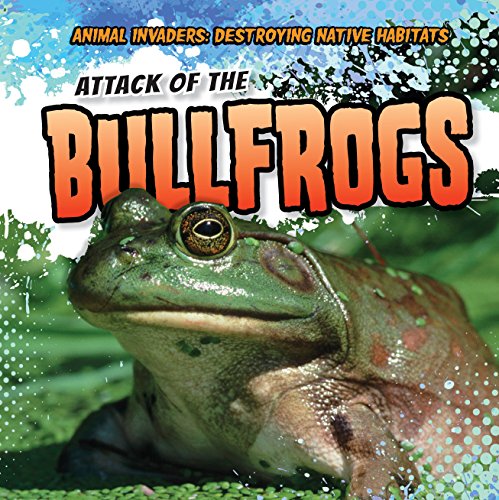-
Attack of the Killer Bees
Emily Mahoney
Library Binding (Gareth Stevens Pub, Jan. 1, 2017)"Since the mating of certain European and African bees in Brazil during the late 1950s, an aggressive bee has been slowly heading northward. These Africanized honeybees are known as invasive species today as they disrupt the ecosystems they enter. More information about the killer bees spread draws readers into the interesting scientific topic of invasive species"-- O
O
-
Attack of the Asian Carp
Santana Hunt
Paperback (Gareth Stevens Pub, Jan. 1, 2017)In the 1970s, Asian carp were brought to Arkansas fish farms. Many escaped, and theyve been invading US waterways ever since. Through the story of the Asian carp, readers learn about invasive species and the harm they cause to native plants and animals. Examples of recent attempts at controlling the Asian carp population, accompanying fact boxes, full-color photographs, and maps help readers understand the extent of the invasion. An overarching theme of conservation and respect for existing ecosystems add to the main contents inclusion of science curriculum topics such as animal life cycles and food chains. K
K
-
Attack of the Bullfrogs
Therese Shea
Paperback (Gareth Stevens Publishing, Jan. 1, 2017)Bullfrogs in the United States started as a way for Californians to eat more frog legs. Now, the bullfrog population grows almost completely unchecked. In many places in the world where bullfrogs have spread, there arent predators to eat them! Readers are likely familiar with the bullfrog croak, but in this book, theyll learn why hearing it is a bad sign! The main content introduces the definition of invasive species and explains through the bullfrogs story the harm these animals cause. Full-color photographs help readers identity bullfrogs, and informative fact boxes add details about conservation, habitats, and food chains. P
P
-
Attack of the Zebra Mussels
Michael Rajczak
Paperback (Gareth Stevens Pub, Jan. 1, 2017)Boaters on the Great Lakes often see clusters of small mussels stuck to docks, rocks, and even boats! Called zebra mussels, these organisms can cause people to cut their feet, filter out food for larval fish, and more. Through reading about how zebra mussels came to these freshwater lakes, readers learn what invasive species are and how they can cause great harm to native ecosystems. Facts about the spread of zebra mussels and efforts to stop this spread introduce readers to conservation and other science curriculum topics. Full-color photographs, fact boxes, and maps showing zebra mussel distribution augment readers understanding. P
P
-
Attack of the Burmese Pythons
Matt Jankowski
Paperback (Gareth Stevens Pub, Jan. 1, 2017)Includes bibliographical references and index. P
P
-
Attack of the Stink Bugs
Michael Rajczak
Paperback (Gareth Stevens Pub, Jan. 1, 2017)Though stink bugs werent introduced to the United States until the 1990s, this invasive species has spread to nearly every state in the country. Their biggest enemies? Farmers who dont like them feeding on crops and fruits. Readers dont need to smell a squished stink bug to understand the harm they can cause not only to crops, but also to native species. The main content and fact boxes discuss how the stink bugs ended up in the United States and the efforts being made to stop their population from growing even more. P
P
-
Attack of the Killer Bees
Emily Jankowski Mahoney
Paperback (Gareth Stevens Pub, Jan. 1, 2017)Since the mating of certain European and African bees in Brazil during the late 1950s, an aggressive bee has been slowly heading northward. These Africanized honeybees are known as invasive species today as they disrupt the ecosystems they enter. More information about the killer bees spread draws readers into the interesting scientific topic of invasive species. Fascinating fact boxes and terrifying maps of the bees spread highlight how serious a threat invasive species are. With discussions about ecosystem balance, food chains, and conservation, the main content undoubtedly supplements the science curriculum. O
O
-
Attack of the Bullfrogs
Therese Shea
Library Binding (Gareth Stevens Pub, Jan. 1, 2017)Describes how bullfrogs have become a dangerous invasive species in North Amercia and explains why they are harmful to the environment. T
T
-
Attack of the Zebra Mussels
Michael Rajczak
Library Binding (Gareth Stevens Pub, Jan. 1, 2017)Boaters on the Great Lakes often see clusters of small mussels stuck to docks, rocks, and even boats! Called zebra mussels, these organisms can cause people to cut their feet, filter out food for larval fish, and more. Through reading about how zebra mussels came to these freshwater lakes, readers learn what invasive species are and how they can cause great harm to native ecosystems. Facts about the spread of zebra mussels and efforts to stop this spread introduce readers to conservation and other science curriculum topics. Full-color photographs, fact boxes, and maps showing zebra mussel distribution augment readers understanding. O
O
-
Attack of the Asian Carp
Santana Hunt
Library Binding (Gareth Stevens Pub, Jan. 1, 2017)Looks at how the Asian carp has become an invasive species in North America, examining how they were introduced, the damage they cause, how they have spread, and the efforts that are being made to keep them out of the great lakes. K
K
-
Attack of the Burmese Pythons
Matthew Jankowski
Library Binding (Gareth Stevens Pub, Jan. 1, 2017)Includes bibliographical references and index. P
P
-
Attack of the Stink Bugs
Michael Rajczak
Library Binding (Gareth Stevens Pub, Jan. 1, 2017)Though stink bugs werent introduced to the United States until the 1990s, this invasive species has spread to nearly every state in the country. Their biggest enemies? Farmers who dont like them feeding on crops and fruits. Readers dont need to smell a squished stink bug to understand the harm they can cause not only to crops, but also to native species. The main content and fact boxes discuss how the stink bugs ended up in the United States and the efforts being made to stop their population from growing even more. P
P